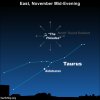Meteor forecasters are calling for the peak of the North Taurid meteor shower late evening Monday, November 11 until dawn Tuesday, November 12, 2013. This is a somewhat rambling – and sparse – shower, and we’ve been hearing from a few people who have seen meteors already, especially throughout this weekend. Generally speaking, the North Taurid meteors are few and far between at mid-evening and tend to pick up steam around midnight. Best time to watch will be the hours before dawn. Expect as many as 5 to 10 meteors per hour. There will be a bright waning gibbous moon in the sky this evening, which, fortunately, will set around the time the shower is picking up.

The North Taurid meteors are named for the constellation Taurus the Bull because the meteors appear to radiate from this part of the starry sky. In fact, the radiant for this shower is not far from the famous Pleiades star cluster, also known as the Seven Sisters, in Taurus. Taurus rises over the northeast horizon around 7 to 8 p.m. at mid-northern latitudes. At temperate latitudes in the Southern Hemisphere, Taurus rises a few hours later.
Taurus climbs upward as evening deepens into late night, and soars highest for the night shortly after midnight. The higher that Taurus appears in your sky, the more meteors that you’re likely to see. Because Taurus is a northern constellation, it climbs higher in the Northern Hemisphere sky than for our cousins in the Southern Hemisphere.
You don’t need to find the constellation Taurus to enjoy the North Taurid meteor shower. But you do need to find a dark, open sky and to be mindful of the setting time of the moon. Be sure to take along a reclining lawn chair for comfort.
Bottom line: From midnight November 11, 2013 until dawn on November 12, you might see as many as 5 to 10 North Taurid meteors per hour in a dark sky. Some might be bright! Best time to observe: After moonset on the morning of November 12.

The North Taurid meteors are named for the constellation Taurus the Bull because the meteors appear to radiate from this part of the starry sky. In fact, the radiant for this shower is not far from the famous Pleiades star cluster, also known as the Seven Sisters, in Taurus. Taurus rises over the northeast horizon around 7 to 8 p.m. at mid-northern latitudes. At temperate latitudes in the Southern Hemisphere, Taurus rises a few hours later.
Taurus climbs upward as evening deepens into late night, and soars highest for the night shortly after midnight. The higher that Taurus appears in your sky, the more meteors that you’re likely to see. Because Taurus is a northern constellation, it climbs higher in the Northern Hemisphere sky than for our cousins in the Southern Hemisphere.
You don’t need to find the constellation Taurus to enjoy the North Taurid meteor shower. But you do need to find a dark, open sky and to be mindful of the setting time of the moon. Be sure to take along a reclining lawn chair for comfort.
Bottom line: From midnight November 11, 2013 until dawn on November 12, you might see as many as 5 to 10 North Taurid meteors per hour in a dark sky. Some might be bright! Best time to observe: After moonset on the morning of November 12.
